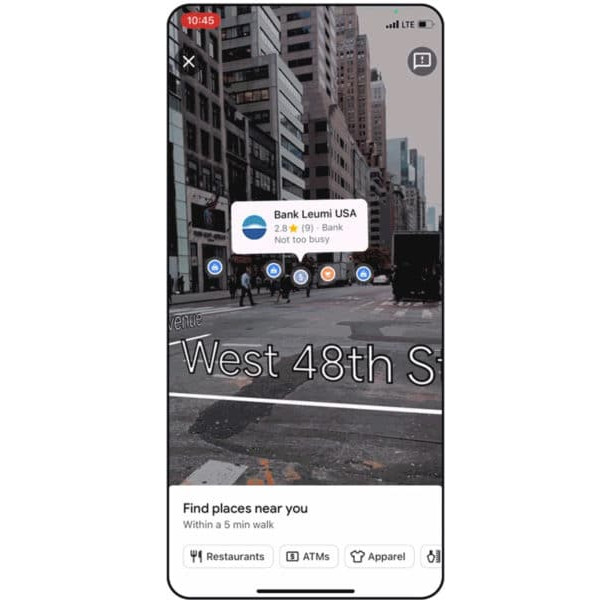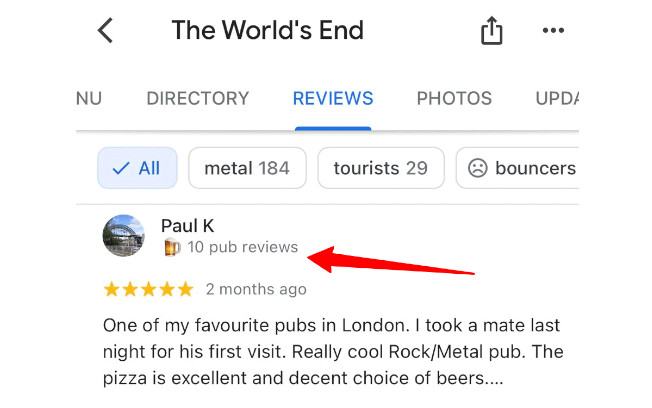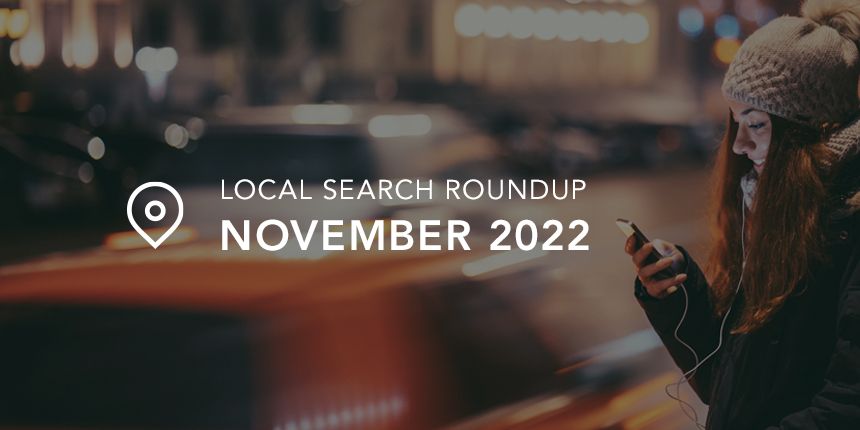The holiday season is here and the pace of change is picking up in local search. Now is the time to catch up with all the news you need to know from one of the fastest moving fields in digital. Let’s get started!
New features for Search, Shopping, and Maps
Google rarely launches new features during the holiday season because unexpected ranking fluctuations are the last thing businesses want to see during the golden quarter. Even so, the search giant couldn’t help itself this year as it revealed updates in Search, Shopping, Maps, and even Lens that some users in the US are seeing in beta right now.
-
Find food through multisearch
Users in the US can now use Lens in the Google app to take pictures of a dish, add the phase “near me” to their search, and immediately find restaurants that sell it nearby. Without the “near me” qualifier, Google will instead show information about the food item specifically, including pricing, ingredients, and recipes to make it yourself at home.
Restaurants have long been encouraged to upload menus and photos of their offerings. With multisearch now combining both visual and text prompts for user queries, restaurants need to double down on displaying their dishes both on their menus and through their imagery.

GIF: Google
Lens has become very good at identifying food through photos, as evidenced by the release of this feature, but it is still not perfect. Restaurant owners still need to be sure that photos of pancakes, for example, will be correctly identified as such by the algorithm. After all, what is intuitive to a person may not be intuitive to a machine. If you need to perfect this process, simply get in touch with us—we have a solution ready to roll out.
-
Google Lens translation upgraded
Google Lens’s instant translation capabilities are getting a small upgrade for text displayed on complex backgrounds. Rather than covering the original text with the translated wording, Google will now attempt to replicate the background and display the new copy on top. This visual upgrade should make Lens’s translate feature more appealing and more accessible, and will likely increase the size of the user base for the more business-oriented aspects of Lens.
-
Google Shopping gets AR shoes
To further compete with ecommerce behemoths such as Amazon, Google is continuing to upgrade its shopping model using features unique to its platform. Utilising Google’s own augmented reality (AR) capabilities, users can now browse shoes with a 360-degree view in their own living space.
Video: Google
More impressively, users can aim their cameras to have the augmented shoes overlay over their own feet, letting them see what the item would look like without physically having to try them on. This new feature currently works for a small number of footwear brands including Saucony, VANS, and Merrell.
-
New shopping models for AR beauty
Beauty products are also getting the AR treatment as Google adds new search features allowing users to try products on models. In fact, Google’s new photo library comes with 150 models representing a diverse spectrum of skin tones, ages, genders, face shapes, and ethnicities to allow users to accurately test more than 2,000 foundation shades from a wide selection of brands.
-
Google Maps live view search
Google Maps has always been a useful tool for both navigation and researching businesses—and it will soon do both in real-time more effectively than ever. Again using AR, Google will allow users to see relevant data about the businesses they pass as they appear on the live map. By pointing their camera at any businesses they see, Google will pull all relevant Maps data for quick review. Decision-critical local business information such as opening hours, current levels of business, price ranges, and user reviews will all be visible without the user having to navigate away from their live map navigation tool.

Image: Search Engine Land
Local businesses will need to ensure their Maps data is up to date as more users will rely on quick glances to see if the shops they pass are worth visiting. The new feature is already available in major cities such as London, Los Angeles, New York, Paris, San Francisco, and Tokyo, and more are to come as the AR feature undergoes testing and adoption.
-
Google Maps adding EV charging filters and wheelchair accessibility
Maps offers standard navigation features that it knows all users need, such as the ability to avoid toll roads. To further expand this essential functionality, users can now also view all locations with electric vehicle charging stations and wheelchair accessibility. The new charging station feature shows CSS and CHAdeMo charges that offer 50kw or higher, while wheelchair-accessible locations show both viable entrances and generally stair-free places.
Businesses will not have to opt into having their local listings appear when users search for these aspects, but they will need to update the information themselves to guarantee it. There is a wide breadth of filters, attributes, and categories that a user may search, and it is up to local businesses to qualify for every relevant query.
Study: The first 10 reviews in Google are the most vital
All this year and last, Google pushed to make its search engine one of the world’s top review platforms. As users become accustomed to relying on Google reviews before visiting a business, the search giant has in turn made its reviews vital to ranking visibility as well.
A recent local presence management study has shown that for a new business location, the first 10 reviews have the biggest positive impact on rankings. Although those below the 10-review threshold rarely appear in competitive searches, they have the potential to break into the local three pack when their review count finally reaches double digits.
Diminishing returns come from each individual review after that point, but that is not due to reviews no longer being impactful on rankings. Instead, it is because the first 10 reviews give a disproportionate boost compared to many other listing optimisations. If you are a new business or simply a brand opening an additional location, focus heavily on that first batch of reviews containing plenty of positive sentiment.
Google shows number of reviews from reviewers
Google did not become a top review platform simply by increasing its sheer volume of reviews, but by engaging in careful moderation and spam detection to ensure its reviews remain trustworthy. To further fight back against spam and bad actors, Google can now display a reviewer’s review count within the city or category of the business they are reviewing.

Image: Search Engine Roundtable
For reviewers who comment on businesses outside of their usual city or frequented places, their profile may now suggest their feedback is spam or otherwise inauthentic. For business owners who want to flag dubious or low-quality reviews, this snapshot will act as evidence for Google to possibly take action.
Review recency impacts local rankings
Along with the total number of reviews impacting rankings, a new study has confirmed that review recency impacts rankings. Google revealed in past studies that users do not consider reviews over 90 days old to be relevant, which actually led to the Google ranking algorithm devaluing listings without fresh reviews.
Ranking data now indeed shows that there is a direct correlation between new reviews and ranking visibility. More importantly, if your competitors receive new reviews on a weekly, monthly, or any regular interval, your business will likely be held to the same standard. Whatever your local search goals may be, fresh reviews are a must.
From targeted review generation to full-service listings management, we can help you get ahead of the game in local search. Let’s talk!




